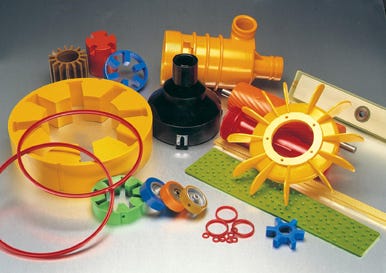Low-cost tooling and extreme wear and abrasion resistance are some of the benefits cast urethanes can offer—properties that could serve a wide variety of end markets. But that doesn’t mean they do.
October 5, 2009
Low-cost tooling and extreme wear and abrasion resistance are some of the benefits cast urethanes can offer—properties that could serve a wide variety of end markets. But that doesn’t mean they do.
“I went to engineering school; I’ve got seven other engineers here; and not one of us had a class in urethanes when we were going to school,” explains Mike Katz, president of custom urethane and rubber processor Molded Dimensions (Port Washington, WI), and VP of the Polyurethane Manufacturers Assn. “We all learned about metal and fractured metal problems, and the younger people learned about plastic, but nobody learned about a single thermoset, and that would be similar with all our customers.”
|
That general ignorance concerning the material and process, generally known as hot cast pouring or performance polyurethane, means that for Katz and other cast-urethane companies, the first step is to educate people about the benefits of the technology, which sees use in a wide range of end markets. “We like to say [markets range] from marine to medical and everything in between,” Katz explains. Mining represents a larger market, thanks to the material’s aforementioned wear and abrasion resistance, as well as its load-bearing capabilities. Parts themselves can vary from 6-ft-diameter sealing surface rings to rollers on roller coasters or pitching machines, to the small gasket in airplane seats that engages when you depress the armrest button to recline.
Cast urethane often replaces metals, with its slight give providing it an advantage over steel, which, in a wear situation, will continually shed small amounts of material. There are barriers to urethanes claiming new turf, but material advances are starting to address these. Chief among the obstacles to greater urethane usage, particularly in automotive, is its lack of high temperature performance.
“The holy grail in urethane is to get it to last at high temperatures so you could go under the hood of a car,” Katz explains. “We’re not there yet, but certainly there have been advances to increase the ability of urethane to go in warmer applications than it used to be.” In a fan belt or tires, urethane would dramatically increase service life compared to the rubber applied today. In addition to higher-heat grades, Katz says there have been applications that satisfy Food & Drug Administration (FDA) regulations, opening new markets, particularly as a replacement for stainless steel.
On the machinery side, Katz says today’s metering and mixing equipment represents a vast improvement over past technology. Specifically, the systems offer greater precision, with mass flow technology replacing gear pumps. “That, in the end, is getting more consistent, higher-quality product for the customer,” Katz says.
Steady prospects
During the current downturn, Katz says the drop in Molded Dimension’s business mirrors the cast urethane industry as a whole, with orders off around 20%—a sizable contraction, but not the freefall experienced in other segments. “It makes sense that polyurethane might go down less than others,” Katz says, explaining that many of the parts the industry makes are wear items that will, eventually, break down. “So [business continues] even if you’re not building new machines or new systems—our customers aren’t building new pitching machines, as an example, but the rollers that are on that pitching machine are still going to wear out over time.” The end result is cast urethane residing in a more narrow peak-to-trough band. “It may be that our peaks are not as high as others’,” Katz says, “but our valleys probably aren’t as low as others’, either.”
Cast urethane’s steady strength also lies in its ability to replace other materials. From a design standpoint, Katz says that for low- to medium-volume products it’s a good alternative for thermoplastics, especially when tooling costs are considered. Unlike plastics, Katz notes that with urethane it’s not as important to maintain constant wall thickness, giving designers more freedom in a part’s shape. —Tony Deligio
About the Author(s)
You May Also Like



